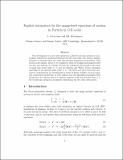Explicit integrators for the magnetized equations of motion in Particle in Cell codes
Author(s)
Patacchini, Leonardo; Hutchinson, Ian Horner
DownloadExplicitMover.pdf (669.5Kb)
PUBLISHER_POLICY
Publisher Policy
Article is made available in accordance with the publisher's policy and may be subject to US copyright law. Please refer to the publisher's site for terms of use.
Alternative title
Explicit time-reversible orbit integration in Particle In Cell codes with static homogeneous magnetic field
Terms of use
Metadata
Show full item recordAbstract
A new explicit time-reversible orbit integrator for the equations of motion in a static homogeneous magnetic field – called Cyclotronic integrator – is presented. Like Spreiter and Walter’s Taylor expansion algorithm, for sufficiently weak electric field gradients this second order method does not require a fine resolution of the Larmor motion; it has however the essential advantage of being symplectic, hence time-reversible. The Cyclotronic integrator is only subject to a linear stability constraint ([OmegaDelta t] < pi, [Omega] being the Larmor angular frequency), and is therefore particularly suitable to electrostatic Particle In Cell codes with uniform magnetic field where [Omega]is larger than any other characteristic frequency, yet a resolution of the particles’ gyromotion is required. Application examples and a detailed comparison with the well-known (time-reversible) Boris algorithm are presented; it is in particular shown that implementation of the Cyclotronic integrator in the kinetic codes SCEPTIC and Democritus can reduce the cost of orbit integration by up to a factor of ten.
Date issued
2008-12Department
Massachusetts Institute of Technology. Department of Nuclear Science and Engineering; Massachusetts Institute of Technology. Plasma Science and Fusion CenterJournal
Journal of Computational Physics
Publisher
Academic Press
Citation
Patacchini, L., and I.H. Hutchinson. “Explicit time-reversible orbit integration in Particle In Cell codes with static homogeneous magnetic field.” Journal of Computational Physics 228.7 (2009): 2604-2615. © 2009 Elsevier Inc.
Version: Original manuscript
ISSN
0021-9991